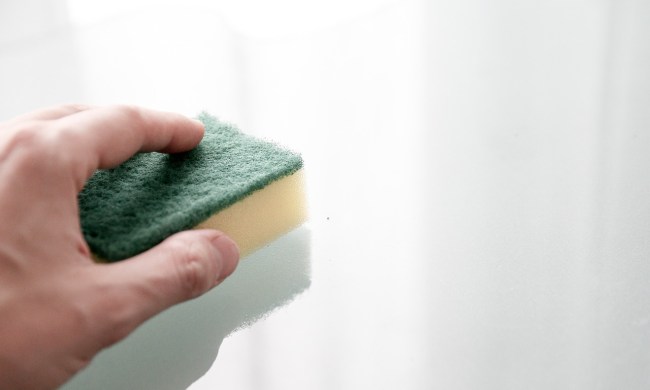
Having a sparkling clean bathroom relaxes the souls of neat freaks like us, but sometimes we fall behind in our bathroom cleaning schedule. Particularly in the shower, you might see that weird orange- or pink-colored mold forming on your shower walls, tiles, or shower curtain. Sometimes it even forms around your toilet. We’re going to discuss how to get rid of this gross substance, but first, we’ll dive into what that pink mold is and how it got there.

What is that pink mold in your shower?
You may be surprised to learn that this pink, slimy substance in your shower isn’t actually mold. It’s a bacteria called Serratia marcescens. This bacteria is airborne, so it can travel virtually anywhere, but it thrives in the moist, humid environment your bathroom provides. It likes to feed off of minerals and fats often found in the shampoo deposits and soap scum that builds up in your shower.
Is Serratia marcescens dangerous?
The bacteria isn’t harmful when touched in the shower or breathed in from the air. However, it has been known to cause eye infections, particularly when it contaminates contact lenses and urinary tract infections when the tub is not cleaned before a bath. Plus, it’s just slimy and gross to look at, so you definitely want it out of your shower.

Cleaning pink mold off of the shower curtain and liner
To thoroughly clean your shower curtain and liner and rid it of that pink bacteria, there are a few steps you should take.
- Fill a spray bottle with equal parts water and bleach. If your shower curtain or liner aren’t white, you can use a color-safe bleach like OxiClean.
- Spray the mixture on the shower curtain and liner, and let it sit for at least 10 minutes so that it effectively kills the bacteria in the pink slime.
- Wipe off the mixture with a clean rag and then rinse with hot water.
- If your curtain and liner are machine washable, it’s a good idea to pull them down and throw them in the washing machine with both laundry detergent and some standard or color-safe bleach. Make sure to follow the care instructions for both the curtain and the liner when washing in the machine.

Ridding your shower’s walls and doors of pink mold
- Mix 1/4 cup baking soda and 1 tablespoon of dish soap to form a paste.
- Apply the pasty mixture to the walls and doors using a soft-bristled brush, scrubbing off the pink mold.
- Rinse the walls and door with hot water.
- Since the shower will need to be disinfected to prevent the pink stuff from coming back, spray the bleach and water solution on the walls and the door, and let it sit for 10 minutes.
- Rinse and dry the walls and door thoroughly.

Does pink mold turn into black mold?
No, pink mold will not turn into black mold. The two are completely different. Still, some pink molds may turn brown or black on their edges. This is no cause for alarm because pink mold is not as dangerous as black mold, although it can still cause some health problems. If you have a sore or open wound that comes in contact with pink mold, this could lead to infection. It has also caused respiratory issues in some people. So although your pink mold will not turn into a toxic black mold, it is still best to remove it from your bathroom.

How to get rid of pink mold in your tile and grout
Your tile and grout can be cleaned with the same baking soda paste and bleach mixture you used for the shower walls and door. If your tiles are natural stone, however, you shouldn’t use bleach very often, as it will eventually damage the stone. Once the stone is cleaned, make sure you get it sealed as often as possible, and keep the tiles clean and dry when you can.

Keeping your bathroom free of Serratia marcescens
If you’re looking for a magic cleaning solution or ingredient that will keep this slimy pink bacteria at bay, you’ll be disappointed. The only real way to keep Serratia marcescens at bay is with regular bathroom cleaning. Some extra tips beyond regular cleaning are:
- Keep your shower curtain closed so that it dries easily after showering.
- Keep surfaces dry as often as possible to discourage the presence of bacteria.
- Scrub soap scum away every week if possible.
- Clean up soap and shampoo spills in the shower right away.
Your bathroom doesn’t have to be gross — it can actually be one of the most glamorous rooms in your home! That slimy bacteria, or “pink mold,” is common, but it’s incredibly preventable with diligent bathroom cleaning habits. If you’re struggling to get the pink slime under control, these methods will get rid of it, and upping your cleaning game will keep it away for good.



